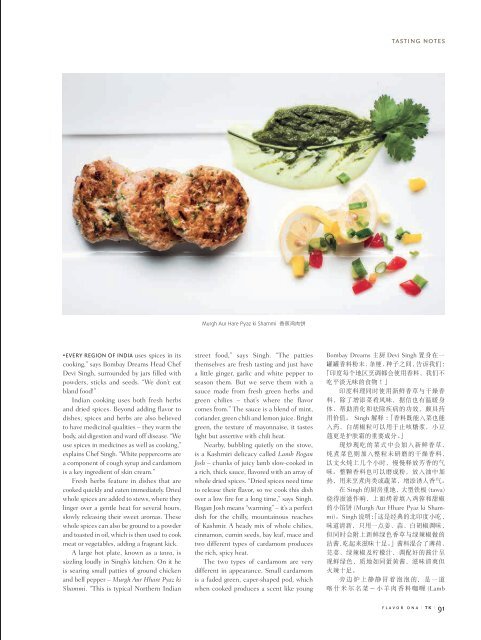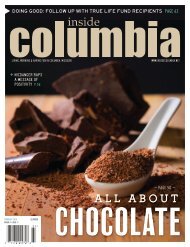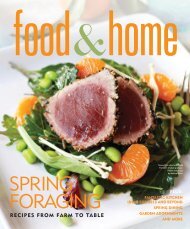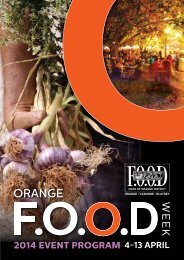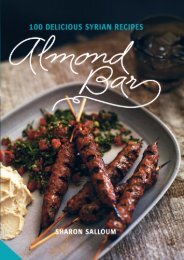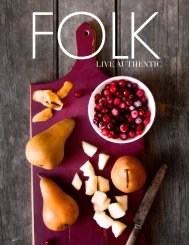Tasting Kitchen
Welcome to Tasting Kitchen. Season’s Greetings – or should I say Seasonings Greetings! This holiday TK issue is full of spices and flavorings. We talk to four talented and ambitious chefs about the flavor profile – or Flavor DNA – of dishes from India, Sichuan, Vietnam and the Isaan region of Thailand. Think cardamom, black salt and saffron, red peppercorns, red chilies and green chilies, dill, Kaffir lime, lemongrass, coriander, galangal and turmeric. We take a look at spices in history, and how even back in the Middle Ages savvy marketers knew the value of a good story. Spice merchants claimed that birds used cinnamon sticks to make giant nests in the cliffs above beaches in India, which “cinnamon hunters” then plotted to obtain. Today India is still associated with the world’s best spices. In this issue, for our first Tasting Destinations feature, TK’s Director of Photography David Hartung and Senior Writer Lucy Morgan traveled to Old Delhi to visit the world’s largest spice market and to New Delhi to visit one of the world’s top restaurants for modern Indian cuisine. One of our featured wines is the peppery Austrian Grüner Veltliner. We also talk to a New Zealand Wine Master about what makes great wine great, and to a leading French Champagne Chef de Cave about the value of patience and restraint. There are also some crabs running loose in the issue. A master chef in Macau shares his recipe for Quinoa Lobster Salad while five more from Hong Kong and Singapore share their favorite crab dishes and culinary musings. Happy Holidays,
Welcome to Tasting Kitchen.
Season’s Greetings – or should I say
Seasonings Greetings!
This holiday TK issue is full of spices and
flavorings.
We talk to four talented and ambitious
chefs about the flavor profile – or Flavor DNA
– of dishes from India, Sichuan, Vietnam and
the Isaan region of Thailand. Think cardamom,
black salt and saffron, red peppercorns, red
chilies and green chilies, dill, Kaffir lime,
lemongrass, coriander, galangal and turmeric.
We take a look at spices in history, and
how even back in the Middle Ages savvy marketers knew the value of a good story.
Spice merchants claimed that birds used cinnamon sticks to make giant nests in the
cliffs above beaches in India, which “cinnamon hunters” then plotted to obtain.
Today India is still associated with the world’s best spices. In this issue, for
our first Tasting Destinations feature, TK’s Director of Photography David Hartung
and Senior Writer Lucy Morgan traveled to Old Delhi to visit the world’s largest
spice market and to New Delhi to visit one of the world’s top restaurants for modern
Indian cuisine.
One of our featured wines is the peppery Austrian Grüner Veltliner. We also
talk to a New Zealand Wine Master about what makes great wine great, and to a
leading French Champagne Chef de Cave about the value of patience and restraint.
There are also some crabs running loose in the issue. A master chef in Macau
shares his recipe for Quinoa Lobster Salad while five more from Hong Kong and
Singapore share their favorite crab dishes and culinary musings.
Happy Holidays,
Create successful ePaper yourself
Turn your PDF publications into a flip-book with our unique Google optimized e-Paper software.
tasting notes<br />
Murgh Aur Hare Pyaz ki Shammi 香 煎 鸡 肉 饼<br />
“EVERY REGION OF INDIA uses spices in its<br />
cooking,” says Bombay Dreams Head Chef<br />
Devi Singh, surrounded by jars filled with<br />
powders, sticks and seeds. “We don’t eat<br />
bland food!”<br />
Indian cooking uses both fresh herbs<br />
and dried spices. Beyond adding flavor to<br />
dishes, spices and herbs are also believed<br />
to have medicinal qualities – they warm the<br />
body, aid digestion and ward off disease. “We<br />
use spices in medicines as well as cooking,”<br />
explains Chef Singh. “White peppercorns are<br />
a component of cough syrup and cardamom<br />
is a key ingredient of skin cream.”<br />
Fresh herbs feature in dishes that are<br />
cooked quickly and eaten immediately. Dried<br />
whole spices are added to stews, where they<br />
linger over a gentle heat for several hours,<br />
slowly releasing their sweet aromas. These<br />
whole spices can also be ground to a powder<br />
and toasted in oil, which is then used to cook<br />
meat or vegetables, adding a fragrant kick.<br />
A large hot plate, known as a tawa, is<br />
sizzling loudly in Singh’s kitchen. On it he<br />
is searing small patties of ground chicken<br />
and bell pepper – Murgh Aur Hhare Pyaz ki<br />
Shammi. “This is typical Northern Indian<br />
street food,” says Singh. “The patties<br />
themselves are fresh tasting and just have<br />
a little ginger, garlic and white pepper to<br />
season them. But we serve them with a<br />
sauce made from fresh green herbs and<br />
green chilies – that’s where the flavor<br />
comes from.” The sauce is a blend of mint,<br />
coriander, green chili and lemon juice. Bright<br />
green, the texture of mayonnaise, it tastes<br />
light but assertive with chili heat.<br />
Nearby, bubbling quietly on the stove,<br />
is a Kashmiri delicacy called Lamb Rogan<br />
Josh – chunks of juicy lamb slow-cooked in<br />
a rich, thick sauce, flavored with an array of<br />
whole dried spices. “Dried spices need time<br />
to release their flavor, so we cook this dish<br />
over a low fire for a long time,” says Singh.<br />
Rogan Josh means “warming” – it’s a perfect<br />
dish for the chilly, mountainous reaches<br />
of Kashmir. A heady mix of whole chilies,<br />
cinnamon, cumin seeds, bay leaf, mace and<br />
two different types of cardamom produces<br />
the rich, spicy heat.<br />
The two types of cardamom are very<br />
different in appearance. Small cardamom<br />
is a faded green, caper-shaped pod, which<br />
when cooked produces a scent like young<br />
Bombay Dreams 主 厨 Devi Singh 置 身 在 一<br />
罐 罐 香 料 粉 末 、 条 梗 、 种 子 之 间 , 告 诉 我 们 :<br />
「 印 度 每 个 地 区 烹 调 都 会 使 用 香 料 , 我 们 不<br />
吃 平 淡 无 味 的 食 物 !」<br />
印 度 料 理 同 时 使 用 新 鲜 香 草 与 干 燥 香<br />
料 , 除 了 增 添 菜 肴 风 味 , 据 信 也 有 温 暖 身<br />
体 、 帮 助 消 化 和 祛 除 疾 病 的 功 效 , 颇 具 药<br />
用 价 值 。 Singh 解 释 :「 香 料 既 能 入 菜 也 能<br />
入 药 , 白 胡 椒 粒 可 以 用 于 止 咳 糖 浆 , 小 豆<br />
蔻 更 是 护 肤 霜 的 重 要 成 分 。」<br />
现 炒 现 吃 的 菜 式 中 会 加 入 新 鲜 香 草 ,<br />
炖 煮 菜 色 则 加 入 整 粒 未 研 磨 的 干 燥 香 料 ,<br />
以 文 火 炖 上 几 个 小 时 , 慢 慢 释 放 芳 香 的 气<br />
味 。 整 颗 香 料 也 可 以 磨 成 粉 , 放 入 油 中 加<br />
热 , 用 来 烹 煮 肉 类 或 蔬 菜 , 增 添 诱 人 香 气 。<br />
在 Singh 的 厨 房 重 地 , 大 型 铁 板 (tawa)<br />
烧 得 滋 滋 作 响 , 上 面 烤 着 填 入 鸡 蓉 和 甜 椒<br />
的 小 馅 饼 (Murgh Aur Hhare Pyaz ki Shammi)。<br />
Singh 说 明 :「 这 是 经 典 的 北 印 度 小 吃 ,<br />
味 道 清 新 , 只 用 一 点 姜 、 蒜 、 白 胡 椒 调 味 ,<br />
但 同 时 会 附 上 新 鲜 绿 色 香 草 与 绿 辣 椒 做 的<br />
沾 酱 , 吃 起 来 滋 味 十 足 。」 酱 料 混 合 了 薄 荷 、<br />
芫 荽 、 绿 辣 椒 及 柠 檬 汁 , 调 配 好 的 酱 汁 呈<br />
现 鲜 绿 色 , 质 地 如 同 蛋 黄 酱 , 滋 味 清 爽 但<br />
火 辣 十 足 。<br />
旁 边 炉 上 静 静 冒 着 泡 泡 的 , 是 一 道<br />
喀 什 米 尔 名 菜 - 小 羊 肉 香 料 咖 喱 (Lamb<br />
flavor dna | TK | 91


